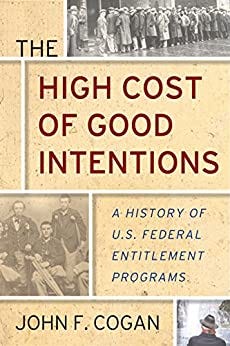When Help Hurts
The Gist: Federal entitlements have routinely punished work and marriage while displacing community help.
A review of The High Cost of Good Intentions by John Cogan.
The second of three parts. Click here for part one, and here for part three.
In 1974, Linda Taylor was arrested in a Cadillac “on suspicion of defrauding the state of $154,000 in welfare benefits. She allegedly used twenty-seven aliases, thirty-one addresses, twenty-five phone numbers, and three Social Security numbers.” She was the original “welfare queen” and became “a national symbol of welfare fraud and abuse.”
Figure 1. To be fair, this was just keeping up with the Standard of the World. Her mistake was being a U.S. citizen.
Taylor was just one notorious example of fraud and abuse that continue to this day. But there are deeper moral problems at the heart of our welfare state. Yes, entitlements are the biggest drivers of our growing debt that is leading toward national catastrophe. As Ronald Reagan observed, “Many of these programs may have come from a good heart, but not all have come from a clear head—and the costs have been staggering. We can be compassionate about human needs without being complacent about budget extravagance.”
Figure 2. Ronald Reagan would have been a good coach on Friday Night Lights. Especially if he asked them to win one for the Gipper
But perhaps more significantly, the High Cost of Good Intentions includes robbing Americans of the sources of dignity in their life: federal entitlements have routinely punished work, punished marriage, and displaced community help – all at the cost to those we were trying to help.
Until well into the 20th century, local governments were the primary providers of aid – and they did so only to those who had been members of their community for a long time. State governments stepped in to help the roving poor that locals did not want to attract with generosity.
The prevailing Constitutional interpretation was that the Founding Fathers had specified a finite, precise number of things that the federal government could do – and aid to citizens who had not served their country was not one of them. Of course, that didn’t stop people from trying to adjust that arrangement: There was a multiple decade effort to involve the federal government in the care for the mentally ill. The closest the movement came to success was Congress voting to sell federal land to states for the construction of asylums. President Franklin Pierce vetoed it as noble but unconstitutional.
Figure 3. That was not the whole story regarding the federal government’s responsibility. The American people have long considered Congress the proper venue for housing the crazy.
There is one exception where the federal government did play a role: helping freed slaves after the Civil War. But the creators of the Freedmen’s Bureau always thought it was a temporary postwar measure and as soon as Southern states re-entered the union (and regained federal legislators), the Bureau was defunded and abolished. Still, over seven years, the Bureau taught and provided healthcare for hundreds of thousands while giving millions food rations. Yet, in the story of American entitlements, it appears to have had no impact on the debate.
Local governments were still the lead, and they attempted to be very careful in dispensing aid:
Throughout colonial times and well into the late nineteenth century, welfare administrators and social reformers distinguished between two groups. The first consisted of poor people who through no fault of their own were unable to provide for themselves and were viewed as worthy of help: the frail elderly, the disabled, and children of single mothers unable to care for them. The second group consisted of able-bodied adults who could work but were nevertheless destitute. Welfare administrators and social reformers believed that poverty among the latter group resulted from human frailties: idleness, intemperance, and immorality. Great care, therefore, was taken in providing government aid for fear that it would encourage greater dependency.
At first local governments pursued institutions: “almshouses for the elderly poor and disabled, orphanages for children, mental asylums for the insane, and workhouses for the able-bodied poor.” The thought was that they would help the needy and deter the able-bodied. But the institutions were chronically underfunded and conditions became scandalous.
Figure 4. There was a missed opportunity to turn close-talkers into bubble boys but who knows where it would have ended before we had to double dip into reserves? Amplifiers for low-talkers? Sponge subsidies? Puffy shirts for the homeless? What we need is federal government shrinkage to achieve serenity now. Giddyup.
By 1900, reformers were keen to provide direct assistance to the poor, relying on local knowledge to determine the worthy, but they were desperate to avoid incentivizing moral misbehavior – and larger welfare rolls. As a result, states for decades extended direct assistance almost only to widows. Though they gradually softened their position, “in the early 1930s, 82 percent of families receiving assistance were headed by a widowed mother… By 1934, only three states specifically granted eligibility to children of unmarried mothers, and fewer than half the states granted eligibility to children of divorced parents.”
FDR changed things. “The New Deal broke new ground by extending entitlements to people in the general population who had performed no particular service to the federal government” – and, indeed, curtailed entitlements to those who had performed service. Our courts caved to intense political pressure, allowing new programs and regulations that were never thought legal.
Along the way, the New Deal “permanently altered the balance in the federalist system that the founding fathers had carefully constructed by profoundly changing the relationship between the federal government and the individual… Today, it is hard to think of a single traditional state government activity that has not also been undertaken by the federal government.” Still, it’s noteworthy that the bulk of the New Deal was designed to supplement states rather than replace them, providing federal matching dollars to locals for helping the poor and the elderly while relying on locals to determine worthiness.
Figure 5. One Tennessee activity I wish the federal government would copy is not taxing my income
But with the Great Depression happening and free money from the federal government, states went on a spending spree and liberalized their aid. From 1934 to 1948, the share of welfare going to households headed by widows dropped from over 80% to around 25%. And aid started playing a dramatic role in rearranging relationships: “By 1948, the U.S. divorce rate was 35 percent higher than its prewar level in 1940; the out-of-wedlock birth rate was 44 percent higher… Welfare’s incentives made it too easy for fathers to avoid their parental responsibility and for poor mothers to rely on government aid rather than their own resources to meet their living expenses… By 1961, only 8 percent of… families were on the rolls because the mother was widowed.”
But not only family stability was affected: for every dollar a woman worked, a dollar was reduced in aid, meaning that recipients were taxed 100% on earnings until they made more money than they received from the government. But why bother? By the 1960s, only 20% of the unmarried women on the government dole worked. Another program for the poor had a “sudden death” provision that immediately cut off all aid once someone hit a certain income threshold – if someone hit the minimum, they’d lose the equivalent of four months of pay! Unfortunately these kinds of disincentives are only a couple of the more dramatic of the past – the problem still exists!
States realized they had been too generous as their budgets busted and scandalous stories started appearing: One woman was “the recipient of $50,000 in public aid over thirty-four years on welfare (over $400,000 in today’s dollars). She had given birth to twenty-two children fathered by seven different men, none of whom had ever been married to her.” So provisions were variously introduced (or started to be enforced) prohibiting aid recipients from living or carrying on with an unrelated man, banning welfare if an additional illegitimate child was born, limiting welfare to no more than 3 months a year, requiring a job, or providing aid only to those who had been residents for years. In fact, 2/3 of states required recipients of old age assistance to have lived in the state for 15 years or more. Arizona required 35!
But instead of reform, the federal government – through both political parties and all three branches of government – declared total war on poverty. While it’s been joked before that poverty won, significant collateral damage included states’ rights and the federal budget.
First, the legal maneuvering: this was not the result of private actors coming forward to advance their case with their own dollars. LBJ financed an army of attorneys to sue his own government (and the states): “The initial legal services’ $42 million budget in 1965 was nearly ten times the total amount spent by all civil legal aid offices in the United States in 1959.” By the beginning of the next decade, the Supreme Court found that states’ “suitable home” provisions were illegal. And struck down state residence requirements for welfare as a violation of an individual’s unspecified constitutional right to travel (but said in-state tuition and state occupational licenses were ok).
Figure 6. Out-of-state college students suddenly discovered a passion for the Constitution as they heard about the right to travel, only to discover that particular penumbra excluded them.
Most significantly, the court discovered a right to government benefits, “fundamentally transforming welfare from an act of legislative charity—a government-granted gratuity—into an entitlement that ensured all eligible people a legal right to benefits. This radical change, occurring without any accompanying legislation, overturned nearly two hundred years of established welfare policy.” Later, courts would find that disability benefits could extend to “virtually all noncitizens whom the Immigration and Naturalization Service was not aggressively seeking to deport” and “loosened eligibility requirements to allow alcoholics and drug addicts to qualify …regardless of whether recipients made any attempt at rehabilitation. By 1994… Only 10 percent of addicts and alcoholics receiving [disability from supplemental security income] were in treatment and only 1 percent of substance abusers on SSI ever recovered sufficiently to get a job. In some instances, SSI had become an enabler of continued substance abuse rather than being a gateway to rehabilitation.”
Second, the joint efforts of Congress and the President. From 1950-1975, “every president proposed to expand at least one existing entitlement or create additional ones” and, simultaneously, every two years Congress “enacted at least one such expansion.” But LBJ, Richard Nixon, and the Great Society hypercharged things. The federal government asserted its role as supreme and “state governments were reduced to acting mainly as administrative agents for these federal programs.” More people were covered than ever – new social workers, food stamps, even coal miners got a piece of the pie. In a cruel irony, the federal government thought that central control might actually curb costs. They failed spectacularly. Some half hearted efforts were tried – they introduced a work requirement in 1969 but the exceptions were massive, including stating that women would only have to work if states provided nonexistent daycare programs. It was still considered too much and was repealed. Another time Congress tried to control future growth of programs. And then repealed the caps two years later.
Figure 7. Millions of little girls were excited by legislation that only placed work requirements on owners of unicorns but they and fiscal conservatives were ultimately disappointed by the results.
From 1964 to 1980, entitlement spending grew 13% a year. The budget was balanced once despite an annual 10% growth in federal revenue: Revenue came in fast but Congress spent it faster. As a result, in 1980, “entitlement spending accounted for over half of all federal government expenditures. So rapid was the growth that the federal government was spending more on entitlements in 1980 than it had on all government activities combined just six years earlier.” And whom were we serving? “By 1981, one-quarter of all recipients of means-tested entitlements lived in nonpoor households, including 40 percent of all food stamp recipients… Half of all U.S. federally subsidized meals were served to students in families with incomes near or above the median family income in the United States.”
Ronald Reagan came in with a new agenda. He tried a lot, failed a lot, and in the end saved Social Security, held spending to a fraction of its former growth, and repealed a few programs along the way.
One of the biggest projects the Reagan Administration took on was weeding out abuse in disability benefits. In the first term, “over 1 million disability benefits were reevaluated and benefits for over 400,000 were terminated.” Nothing like it had occurred since the Roosevelt Administration’s tackling World War I veterans’ benefits half a century earlier. But unlike with FDR, the backlash was immense. The press highlighted recipients whose disability had been revoked, Congress was outraged, and by 1984, “about half of the states were refusing to conduct disability reviews. Disability cases swamped the federal courts. An astonishing 20 percent of all cases pending before all U.S. federal district courts” were from folks removed from disability. “Under siege, the Social Security Administration announced a moratorium on all reviews… by the late 1980s, the program was larger and more generous than it had been when the disability reviews started.”
But that was the only spectacular failure. “Ronald Reagan’s success in reining in entitlements, though modest, is unmatched by any other presidential administration in U.S. history. Legislative actions reduced benefit levels or tightened eligibility rules in all but three entitlement programs.” Two entitlements were eliminated altogether (a program to share money with states, a special Medicare program that the recipients themselves hated) and another (trade adjustment) was reduced by 96%. “Although entitlement spending continued to increase throughout the president’s two terms in office, its growth slowed dramatically.” Compared to the 13 percent annual growth from 1964 to 1980, the Reagan administration saw only 1.4%. “During Reagan’s presidency, the percentage of U.S. households that received assistance from at least one federal entitlement program actually declined.”
Figure 8. Forget Tom Brady or Jerry Rice. Defeating the Evil Empire and making Americans more prosperous and less reliant on government makes Reagan a serious contender for GOAT. But better than Washington, Lincoln, or Polk? Maybe not, but it’s noteworthy that his nearest competition is separated by a century.
Reagan’s approach was restarted by Republicans who took over Congress in 1994 through welfare reform: “The law reversed decades of federal welfare policy by eliminating an individual’s entitlement to Aid to Families with Dependent Children (AFDC) benefits and transferring program policymaking authority to the states. The reform measure was motivated not so much by fiscal concerns but by a bipartisan realization that the AFDC program was encouraging recipients to act in ways that were harmful to the long-run interests of themselves and their families.” They further tackled abuses brought on by the courts by disallowing disability benefits for drug addiction and alcoholism and “denied eligibility for all three welfare programs to almost all legal immigrants.”
The impact was significant: the number of AFDC households plummeted over 50% in five years and nearly another 50% in the next ten. “This remarkable reduction is unprecedented among major entitlement programs in U.S. history.” What’s more: over 60% of adults who left the program became employed and the poverty rate among both children and families headed by women dropped by 20% in 10 years. “Among African American single heads of households, the results have been even more striking. Prior to 1994, their poverty rate had never fallen below 50 percent. By 2001, their poverty rate had declined to 41 percent and has remained below 50 percent every year since, including during the Great Recession.”
And yet the 1996 welfare reform was the exception rather than the rule, even among Republicans. Since then, Republicans and Democrats, Congress and Presidents have continued to expand government commitments, making existing programs more generous to more people and even creating new ones like ObamaCare. Within two years of welfare reform, a Republican Congress had reversed itself and made immigrants eligible for Medicaid benefits, AFDC, social security disability, and food stamps. Food stamps once required recipients to actually pay something for them but became free in the Carter Administration. Since the 1990s, food stamp eligibility expanded and expanded, where “liberalizations increased the amount of personal expenses applicants were permitted to deduct from their countable income, allowed certain types of income to be excluded from countable income, and increased the value of allowable assets.” In other words, Congress kept increasing the value of the cars, housing, retirement accounts, and education accounts recipients could own while still qualifying – and allowed states further ability to waive asset requirements. By 2009, “Congress suspended restrictions on the amount of time an able-bodied person could spend on the food stamp rolls without working” and “waived the food stamp work search requirement.” Welfare reform was a shadow of what it once was.
In my final email (for now) on entitlements, I’ll talk about broad lessons – and how politicians have abused and lied about Social Security.
Figure 9. Click here to buy The High Cost of Good Intentions 10/10, perhaps the most important history book you can read to understand America’s current and future problems.
Thanks for reading! If you enjoyed this review, please sign up for my email in the box below and forward it to a friend: know anyone interested in America’s entitlement programs? How about history generally?
I read over 100 non-fiction books a year (history, business, self-management) and share a review (and terrible cartoons) every couple weeks with my friends. Really, it’s all about how to be a better American and how America can be better. Look forward to having you on board!










